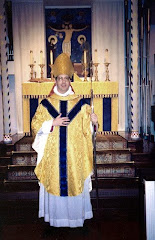
Ruins of church of St. Euphemia looking toward Hagia Sophia (click on photo to enlarge)
The Last Mass in Hagia Sophia
Anonymous Song of Lamentation
for the Fall of Constantinople in 1453.
Translated by Richard Stoneman
God rings the bells, earth rings the bells, the sky itself is ringing,
The Holy Wisdom, the great church, is ringing out the message,
Four hundred sounding boards sound out, and two and sixty bells,
For every bell there is a priest, for every priest a deacon.
To the left the emperor is singing, to the right the patriarch,
And all the columns tremble with the thunder of the chant.
And as the emperor began the hymns to the Cherubim,
A voice came down to them from the sky, from the archangel’s mouth:
"Cease the Cherubic hymn, and let the sacred objects bow;
Priests, take the holy things away, extinguish all the candles:
God’s Will has made our city now into a Turkish city.
But send a message to the West, and let them send three ships:
The first to take the cross, the second to remove the Gospel,
The third, the finest shall rescue for us our holy altar.
Lest it all to those dogs, and they defile it and dishonour it."
The Holy Virgin was distressed, the very icons wept.
"Be calm, beloved lady, be calm and do not weep for them
Though years, though centuries shall pass, they shall be yours again."
Excerpted from:
Greece in Poetry
Simoni Zafiropoulos, ed.
New York: Harry N. Abrams, Inc., Publishers, 1993, p 70.

























5 comments:
Dear Fr.John,
Thank you for this moving story. It also reminds of the Finnish Orthodox loosing the old Valamo Monastry to the Russians. Now they have Uusi Valamo - new Valamo and built a new monastry. There is a link between this story and the disappearing of the solid Catholic Faith within our Episcopal and Anglican Communities, the glory days there are definately over. Thanks be to God, when I see you at work, it is like finding a beacon of light.
Have a blessed day,
Ed Bakker
Dear Father John,
Thanks for this moving piece. It reminds in some ways of the Old Valamo Monastry ( Finnish Orthodox ) going back to Russian Territory. Now they have built a new Monastry on Finnish soil. There is also a link between this story and the disappearance of the true Catholic Faith within our Anglican and ECUSA communities. Let us therefore keep the faith.
Ed Bakker
It wasn't a Mass in Latin, was it? It was most likely the Greek liturgy of St. John Chrysostom (reference to the Cherubic Hymn: "Let us who mystically represent the Cherubim....")
Incidentally, the Hagia Sophia was not used that often after the sack of Byzantium in 1204. It was just too big and lavish to maintain.
As for the Emporer, he died with his boots on, in battle defending the city, and was probably hacked to pieces by Turkish swords. He is venerated as a saint by both in the Orthodox and Catholic Churches, since I believe he died in communion with the Church of Rome.
Now, St. Sophia in Constantinople, the pattern, the prototype of all
Orthodox Churches, is
more than the place where people worship. It is in itself a vision of
the new creation. The
great dome covers not only the Church but potentially the whole world.
St. Sophia exemplifies
the great mysterion , the mystery of the Liturgy in its rich symbolism,
and that great
hymnography which is being sung in church. All this is not only an art
of prayer; it is a
manifestation, the revelation, the communication of that ultimate
reality which, according to
Eastern Orthodoxy, has been revealed to us, communicated to us in
Christ and by Christ - the
reality which, according to another Orthodox saying, makes the life of
the Christian the
heavenly life on earth. (This from the "Orthodox England" web site.)
Very moving piece.
Post a Comment